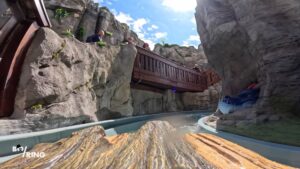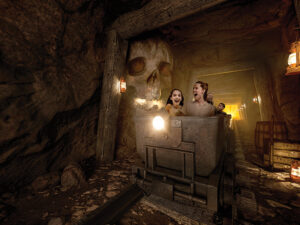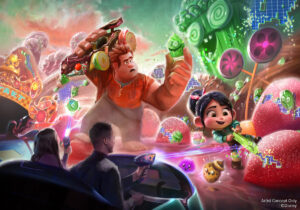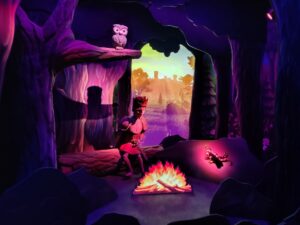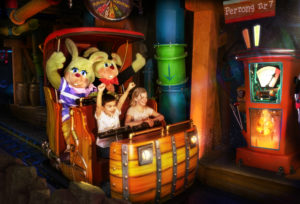Talking with Andreas Andersen about Underlandet

Every park should have a dark ride is a thing we often voice when we talk about dark rides. They are a unique way for a park to differentiate themselves from other parks. So what should a park do when they close their only dark ride? What does it take to design a new dark ride for one of Europes leading theme parks, what challenges does it pose and what lessons can be learned. Those are the questions we tried answering in an interview with Liseberg CEO Andreas Andersen.
Ever since opening in 1923 to celebrate the city of Göteborg’s 300th anniversary, Liseberg has been one of the best visited theme parks in Europe. Whether it is because of the importance to the local population, the great many artists who have performed there in the last 100 years or because of the great variety of rides it offers, the park is a shining example of what a city-based park can offer. Today, Liseberg offers over 40 rides, several outstanding food establishments and several accommodation facilities, of which the latest (Grand Curiosa Hotel) just opened.

In 2021 the park opened its first dark ride in over 50 years, Underlandet, and is located in the parks Kaninlandet (Rabbit Land) section. The attraction tells the tale of the park’s green mascot and his family, offering a timeless dark ride experience with a modern twist, carefully crafted for families to enjoy. Given the significance of this new ride for Liseberg, it served as an ideal topic to discuss with Andreas as we sought answers to our questions.
Liseberg’s dark ride history
In Liseberg’s long history, the park has seen an astonishing list of dark rides appearing and closing on its premises. But despite Liseberg’s size and status, the park did never include a grand dark ride in the way that other parks in Europe, like Efteling and Europa-Park, did. That might be partly explained by the way Liseberg has long been run. Being a Scandinavian city park, similar to Tivoli Gardens in Kopenhagen and Gröna Lund in Stockholm, rides were often run by separate operators, who had to attract as many guests as possible to pay for one ride on their attraction. “This is probably why dark rides have never been super popular on our premises,” Andreas explains. “A lot of operators may have gone for simpler rides, which are easier to build and more visually appealing to the guests visiting the park.”
Nonetheless, the park has seen a wide range of ghost trains and other dark rides on its grounds. The last one that existed before the opening of Underlandet was Sagoslottet, which closed in September 2016 to make way for Valkyria, the park’s new 47-metre-tall B&M dive coaster which opened in 2018. The closure of Sagoslottet, the only dark ride in the park, aroused a strong reaction from the Swedish public, who saw their favourite family-friendly ride being torn down. This made clear, better than anything else, that Liseberg was in need of a replacing dark ride, Andreas acknowledges. “I think any amusement park actually needs a good dark ride. I think it was maybe not as much the closure of this particular dark ride that they were angry about. It was more the fact that we have taken something which is immersive, which is indoor, which is very targeted towards children and which is telling a story.“

Even though Sagoslottet was never a really grand or famous ride, it did have a long history and over all those years, the ride stole the heart of many families visiting Liseberg. Opening originally as Peter Pan, the ride had been in the park since as early as 1968. In 1981, the ride was moved and reopened as Vår Lilla Värld (Our Little World). It received its final retheme to Sagoslottet (Fairytale Castle) in 1985. The ride used a suspended ride system by Anton Schwarzkopf, featuring five vehicles that could hold up to three passengers.
Despite stealing the hearts of the locals, Sagoslottet did not really stand out in terms of quality and had become rather outdated by the time the curtain fell for the ride. The new roller coaster was thus not the only reason to close down this dark ride. “That ride was just horrible,” says Andreas. “I remember we had a visit by a few people from Disney Imagineering. I was taking them around the park and showing them all the rides and new developments. And then they said, we also want to go on the dark ride. And I said, no, you don’t. Nevertheless, they persisted. Because it was a family ride, I didn’t want to bypass the line with all the children, because I think that sends the wrong signal. And they totally understood, so we stood in line for 45 minutes, we rode it, and when we got out they were like, OK, we get it. We understand why you didn’t want us to go on this ride.”
The rabbits of Liseberg
The closure of Sagoslottet thus left Liseberg with a need for a new dark ride. In those days, the 2010s, the park was also building a story around their famous mascot, the green rabbit. That story would eventually proof to be a starting point for the new dark ride. However, even though the rabbit family is now intertwined with Liseberg’s identity, they did not find their way to the park in such a straightforward manner, as Andreas explains. “The CEO of Liseberg back in the 1970s and 1980s was Boo Kinntorph, a big Disney fan. He travelled to the USA every year for the IAAPA Expo, and came back with a lot of Disney inspiration. One of the things that he wanted was a mascot, and in 1980 he came back with five custom characters. One of them was a green rabbit, and that one quickly become the most popular among the guests. Throughout the 1980s, the rabbit became intertwined with Liseberg.”


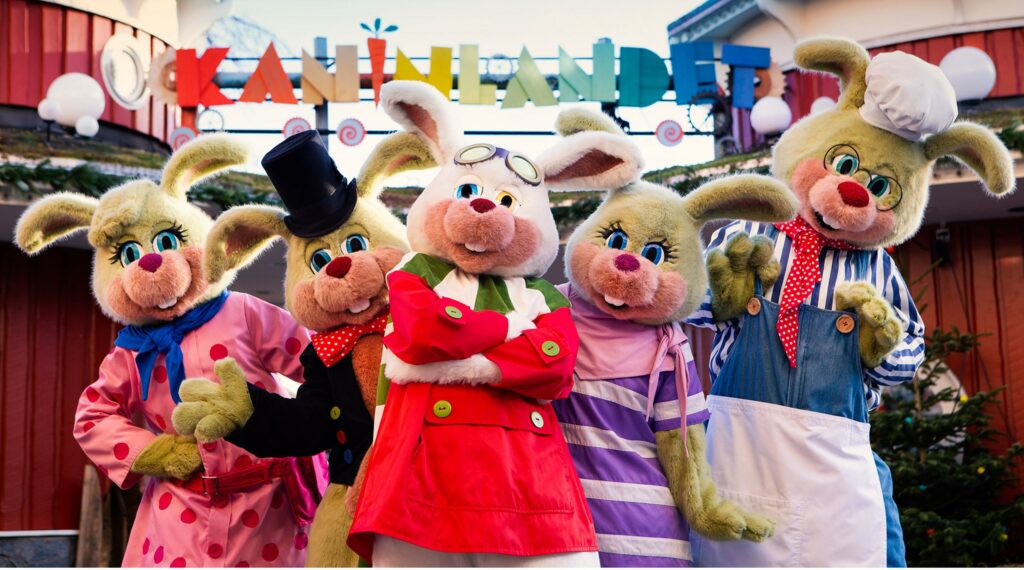
The many mascots of Liseberg through the years (© Liseberg)
In the thirty years since the rabbit’s introduction, the line of mascots gradually increased until he had a family of almost 30 mascots. For the 2013 season the decision was made to reduce the amount of characters in the park and give them their own area, ‘Kaninlandet’. This area would be the sole location to house the park’s mascots. The area was designed with a backstory in mind. “We also built a storyline for ourselves, which we used in the development of the area.” This story however never fully found its way into the 2013 remodelling of the Kaninlandet area. Guests who knew where to look could piece it together, but it wasn’t part of the active storytelling in the area.
The decision to close Sagoslottet just coincided with the idea of building a dark ride in the Kaninlandet area. Andersen tells: “Actually it was part of the master plan back in 2013. We really wanted to tell the story in some form, since we’ve never really told that story to the guests. So, the ambition was to tell that story, or at least try to give them a peek into what that story could look like. You could say those two ideas were combined”
All about the location
Location, for several reasons, is very important for a dark ride. Unlike flat rides and roller coasters a dark ride itself is not visible to the public. So how do you get guest to find and enter a dark ride? And why do you build Underlandet where it’s build? Andersen tells: “What we did was very deliberate, in the sense that we really wanted to hide the show building. Most of the time, the show box is just a big square and it’s just ugly, so we really wanted to hide it.”

With that in mind, the search for a location in and around Kaninlandet started. It proved harder than expected to find the right location. A dark ride with the ability to tell the story the way Liseberg wanted would take up a lot of space, somewhere between 500 and 700 m² according to the parks estimates. The park found the location in a theatre near the edge of Kaninlandet. Andersen tells about the difficulty of finding that location. “I can’t say there was a big master plan decision behind it. We had a theatre there and it was the only place we thought we could squeeze in something new. Obviously we could also build something in other parts of the of the park, but again, if we wanted to tell the story of the rabbits this was the location we had to use.”
“We haven’t had ridership issues at all this summer. I mean people find it and they want to go on it and they wait for it. There are definitely other rides in the park where we sometimes find that the location or the visibility can really work against it. But in this case we’re OK. This idea of sort of going through the backdoor and finding your way through, that’s also part of the idea. You are visiting the rabbit’s secret underground world.”
The location was chosen and with that the park could start on the most important phase of development on Underlandet: The design of the ride.
Choosing the right tone
Once the location was chosen, the park started looking for ideas and inspiration. Before the lay-out and story of the ride would be conceived, the park already needed to make many choices in the type of dark ride they wanted to build. An important factor when designing a dark ride is the type of visitors you want to cater towards. For Liseberg, the target audience was clear from the start. “We wanted to aim our ride especially at smaller children. It should be fun for the whole family of course, but especially for the small children.”
During the initial phase, the park visited several medium-sized dark rides to get a feel for the elements they wanted to incorporate themselves. Liseberg chose not to copy one ride, but to take elements from several rides they felt worked well. Andersen spoke about one of the rides that they looked at for inspiration, Wallace & Gromit’s Thrill-O-Matic in Blackpool Pleasure Beach. “You will find some similarities between the two. The quirkiness, the tongue in cheek, sense of humour and all that. Even though that one is a bit more adult than child friendly.” Many visits to other dark rides later, the park found their inspiration for many of the elements, from the type of storytelling to the type of lighting and quality of the theming.


In the end, the main takeaway for the Liseberg team was their wish for a more traditional dark ride, instead of a media centred dark ride. Andersen had several reasons for this. Firstly, it comes down to the longevity of the media. “You know most media-based rides don’t age very well. There are exceptions, like The Amazing Adventures of Spiderman (Universal Studios Orlando). That ride is from the late 90s and it’s still worldclass. But, I generally think media-based rides do not age very well. And we really wanted to build a ride that could cross generations.”
“The second part obviously is costs. Doing a good media-based ride is just expensive. You can definitely do it, and there are also suppliers that offer budget versions of media-based rides for smaller parks like ours. But you still need to have a rather healthy budget to do a ride like that and we didn’t have unlimited resources.”
“And then lastly, we actually wanted to build something that would be the next generation of Sagoslottet, as it served as replacement of that ride. In that sense, we had a reference. We wanted to build a classic, animatronic based ride, with good lighting, with good set designs, with something that that could be enjoyed by even the smallest of children.”
For similar reasons, Liseberg decided not to add interactivity in the ride. “We didn’t add any gamification. The reason why we didn’t do that is because I feel very often that adding gaming elements to dark rides is being used to fool the guests a little bit. It is as if parks use it to distract their guests, like if you have a game to play, you don’t notice how mediocre the ride is. We didn’t really want to go that route.”
Designing Underlandet
After many inspiring visits, the Liseberg team had found the tone they wanted to achieve with their new ride: a traditional ride with physical sets and animatronics, no gameplay, and aimed at smaller children. That was the point where the park was to decide how to bring those demands further, developing a story and design for the eventual dark ride. Although a good dark ride always starts with an idea, a spark to empower the design team from the start, selecting the right partners is also essential in getting there. There are different approaches a park can take. Several companies offer to build dark rides turn-key, which means those companies take over the project management, design and manufacturing process. They select the right partners and make sure the final product is delivered according to contract and customer’s wishes.
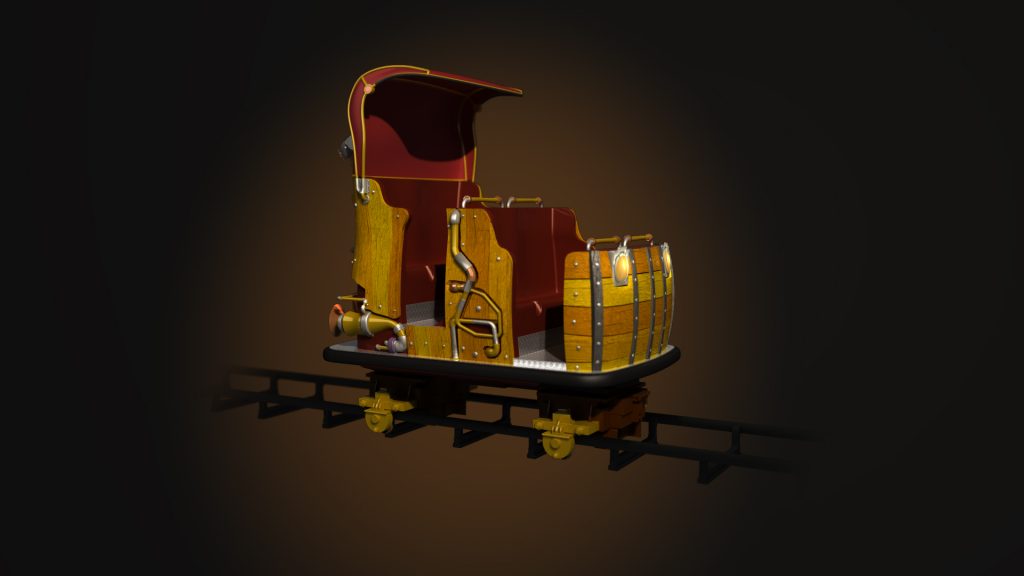
The other option is for the park to do this project management process themselves, selecting their own partners and working together towards the desired outcome. Andersen explains why Liseberg chose the latter “We felt that we really wanted to keep the creative control. Besides, we also know the building codes of Sweden, having to work with the standards that we have to apply”
Taking those words in mind, Liseberg put together a group of designers and manufacturers to help them realize Underlandet. Quarry Fold Studio was put in the lead in the creative department, P&P Projects was responsible for manufacturing the theming and Gosetto was asked to supply the ride system. Andreas tell us: “I remember there was a meeting in October 2018, here in Göteborg, where we all were together. We put all the suppliers together and said we had to meet each other, as from now on we are in the same boat. We are only as strong as our weakest link. We do feel that we put together some really, really good manufacturers and suppliers.”
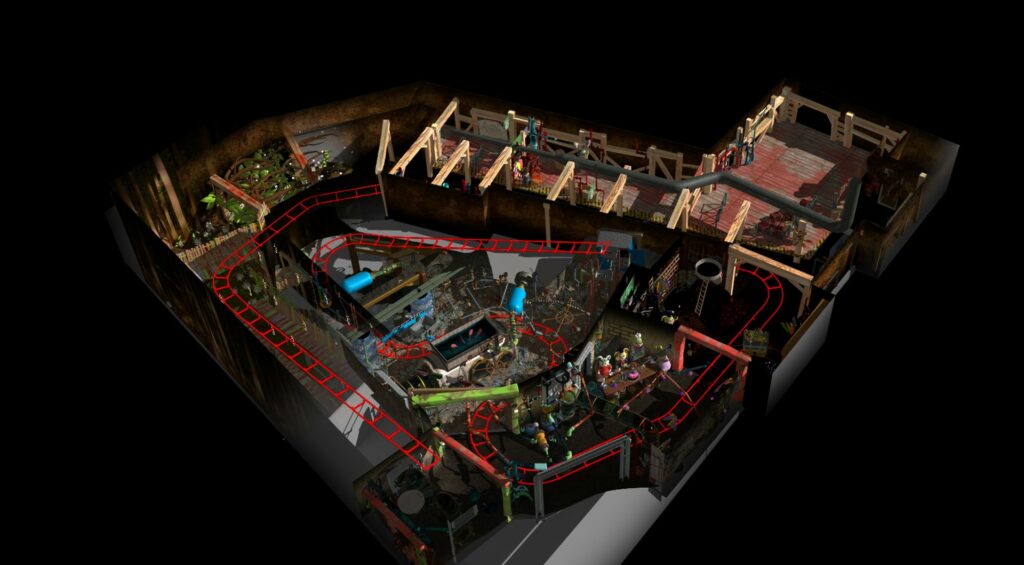

Gosetto was the first to get on board, as Liseberg was of the opinion that they had to get the ride system right first as opposed to setting the experience they wanted first. “Often that developing process is reversed. A park might say we want this experience, then suppliers work backwards from that. We don’t have those kind of resources, so we had to start with the basics. How many meters of track can we get in? So we started with the ride system. Gosetto was probably the first one that got on board.”
With the ride system in place, Liseberg started to develop the story line of Underlandet, seeing how and where the story would unfold and how many animatronics would be needed. From that moment, Quarry Fold Studio and P&P were contacted to help further develop these elements. Having these companies working together was a blessing for the park, since much of the ride design from that moment on was created through co-creation. “The creative process is very dynamic, I think especially with P&P Projects. They really worked on the whole set design. I think a lot of that was like ping-ponging ideas back and forth between us. It’s not like they received the drawing and then they just did it. It was very much an interactive process.”


Working together with so many different manufacturers also means having to make compromises, especially given the tight space Liseberg had to manoeuvre in. Andersen says: “That was also the challenge, to see if all these elements would fit together. Also, from a conceptual point of view, I think that was a little bit of a nail biter. But I think it actually did fit quite well together.”
In the end Liseberg was very happy with the result of the cooperation between all parties involved. Of course, a dark ride never is done. “There are a lot of the things I’m very happy with, but there are also elements of that ride where we have to sort of go back and say, OK, maybe we should rethink this. I think some of the animatronics could definitely be better integrated. there’s also some lighting I would like to change here and there. They are not giant tweaks, but I think there are some. There are a few of the scenes that definitely work better than others.”
Lessons learned and implemented
Once the design phase is completed and the ride is constructed, the operation of the new attraction commences. This phase of the lifecycle brings a new set of obstacles to overcome and learn from. Andersen gave us a look at some of the effects and lessons learned the opening of the new ride had on the park.
After Underlandet opened in 2021, following a 15 month delay caused by COVID-19, guests could finally experience the ride. Fortunately for the Swedish park, visitors thoroughly enjoyed Underlandet. Four years after the closure of Sagoslottet, the park finally had another dark ride to entertain its guests. “Overall, I would say the reception has been really good. Nine out of ten guests love the ride. And very often a ride has to grow on the public. When we opened Kaninlandet for example, it was not instant success at all and today it’s really, really strong. It’s the most popular product we have, and it’s probably the best investment we have added”

Underlandet’s opening and popularity also brought one undesired side effect. The Kaninlandet area already was quite popular with guests, and the opening of Underlandet only increased this. In a sense, Liseberg’s decision to concentrate all children’s rides in one area backfired a bit.
Liseberg found a solution for this, by spreading the rides aimed at this audience throughout the property. To celebrate the parks 100th anniversary it was decided to upgrade an area at the top of the mountain to a new themed land called Luna Park. The new area features two flat rides, a Technical Park Sidecar and a Zamperla Nebulaz, as well as a Vekoma Family Boomerang coaster. Andersen explains this decision: “It’s quite challenging in the sense that it’s very crowded in that area as it is. And this is also one of the reasons why we are now redoing the new area, Luna Park on the mountain, because it’s a little bit the same target group. It’s maybe meant for children which are a bit older, but we really need to distribute our guests better, because they crowd way too much in this area.”

So even though the target audience of Luna Park and Kaninlandet are a bit different, both manage to even each other out a bit. This is also visible in the ages of the Underlandet audience, it’s not entirely the same as the intended target audience. So in the end, it all balances out for Liseberg according to Andersen: “We have more adult riders and we also have more small children than we thought. But I think it’s always this thing when built something for a target group, it always gets a bit broader and I think that’s what has happened with this ride as well.”
Although it’s not a lesson learned on Underlandet, there is one lesson the park didn’t want to forgot: Queue-line design. The way guests are greeted at a ride is crucial. For Underlandet, the Swedish park adopted a unique approach distinct from their other attractions. Liseberg has been exploring virtual queue systems for some time, and with Underlandet, they decided to advance this concept even further. “We have had express passes for our most popular rides for a number of years. And we had a long discussion about adding an express line to this one as well. We chose not to do that. Instead, we went for a virtual queue. The thinking was that if you have a virtual queue, you can play on the playground next door and then when it’s your turn you can go on the ride. And that’s why we have a very short standby line, because we thought most people would take the virtual queue and they do”
Andersen was very clear on the use of paid express passes for the Underlandet ride, it’s not going to happen “It just doesn’t taste very well”
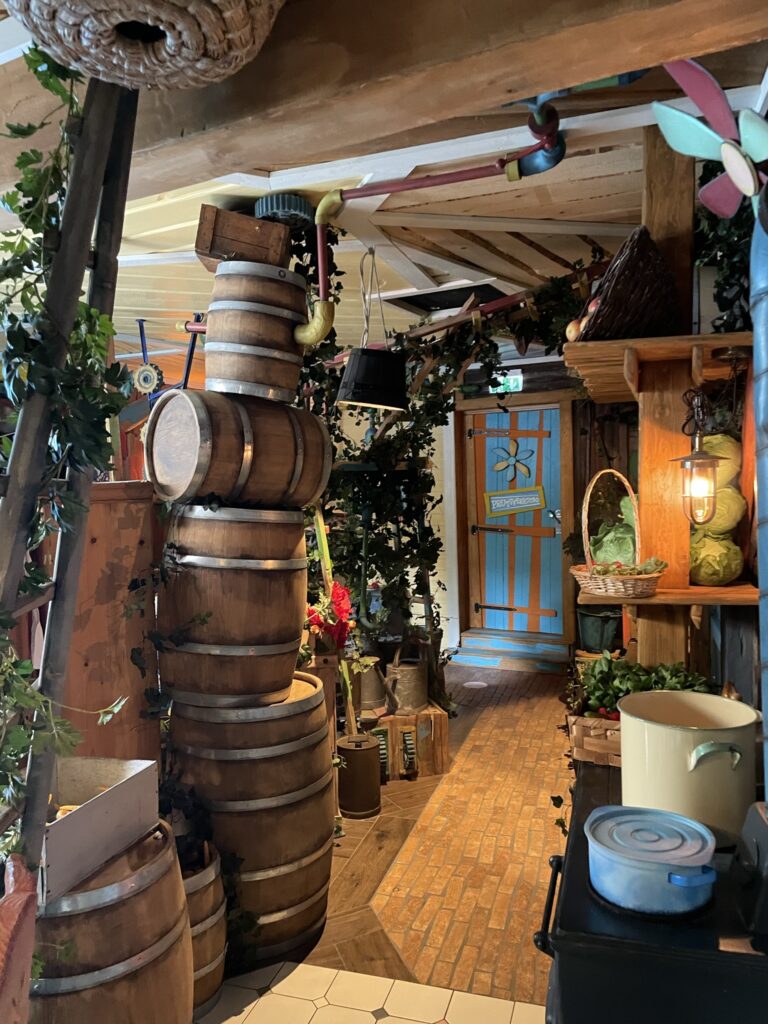



The entrance and queue of Underlandet (© Dark Ride Database)
Closing chapter
Dark rides are expensive to build though. In the end, the available budget is always one of the biggest limiting factors when designing and building a ride. This was no different for Liseberg. “I mean the biggest restriction you always have is money. We spent about €15 million on this ride including building and design. As an example, we looked at trackless rides, or something hanging from the ceiling. And I think we went with the right ride system. We didn’t want to spend everything on the building and on the ride system. We also actually wanted money to spend on the experience.”
Because budget often is one of the restraining factors when designing a ride, we asked Andersen what adding €5 million more to it would have been able to accomplish. Andersen’s answer shows perfectly that a dark ride is a sum of its many, many components, not just a single thing to design and buy. “I think it’s a ladder. I don’t think it’s one thing I would change. I think I would just add more layers. It’s a bit like at Halloween. We have a really nice Halloween event here and we do really good mazes. I think one of the best mazes in the world actually is Gasten, which is operating all year round. That that maze has been improved for over 20 years, so it has all these layers and stories. That’s probably what I would do with this ride, just add layers to it.”

Looking back one last time we ask Andersen what Underlandet brought Liseberg: “A dark ride! I mean that we didn’t really have that and now we do and hopefully it will be the starting point of adding some more of these types of experiences in the future. After you built your first dark ride, you want to build the next”. We can only agree with that sentiment.
With Underlandet finished and in operation it is once again time to look to the future. As Liseberg is always in development, the next big thing is always on the horizon. While Andersen wasn’t able to tell anything about it yet, Dark Ride Database is sure that it will be as amazing and successful as their previous expansions. We’d like to thank Liseberg and Andreas for their hospitality and taking the time to answer our questions.
© 2024 Dark Ride Database
Visit by: Johan
Interview by: Johan & Luc
Article by: Johan
Photos by: Liseberg and Dark Ride Database

